
Edition 179 - April 2019

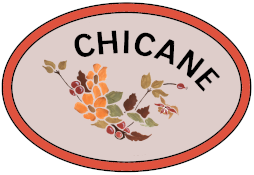
EDITORIAL
When I began working on this issue, we were basking in an unusual spell of beautiful spring weather, but as I get ready to go to print . . . what can I say? And, what can be said about Brexit!
By the time you are reading this, we'll have put the clocks forward and the evenings will have lengthened. The spring flowers, in the gardens and hedgerows, are well advanced but sadly suffering from the wet and strong winds, but at least they make a splash of cheerful colour.
There has been an excellent response from readers who receive their copies in the post. Thank you all for your subscriptions, donations and support of the Newsletter. A big thank you, too, to Maureen and Pat for another enjoyable coffee morning at Fuchsia Cottage in aid of Berry in Bloom and the Newsletter. Cakes to die for and a happy and warm atmosphere. Take care of that leprechaun Tony!
Good wishes, as always, go to those unwell and newcomers to the village; we hope you feel better soon and happiness in your new homes.
For almost as long as there has been a Newsletter, it has been enhanced by the illustrations of our Artist in Residence, Paul, who doesn't even come from the village - he is a star! I am incredibly grateful to him for his help and support. Hopefully, readers will find time to support him and view his exhibition as part of the Ilfracombe Art Trail, details appear in article 25.
Obviously, I am also extremely grateful to everyone who contributes to the Newsletter in so many different ways, especially the regular article writers - keep them coming! And let's have some new contributors too. Items for the June issue would be welcome as soon as possible and by the 6th May at the latest - thank you.
Wishing all readers a Happy Easter.
Judie - Ed
1
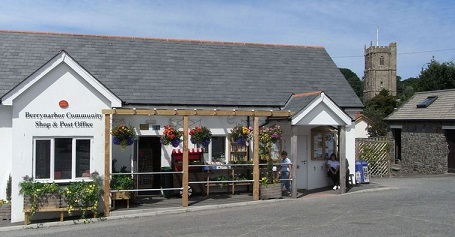
FROM
THE VILLAGE SHOP & POST OFFICE
Easter Draw Prizes for
all the Family
 Tickets
are now on sale at the Village Shop for our Easter raffle. They are just £1 each and if you haven't got
yours yet, you'll need to hurry as the draw will be taking place on Thursday
18th April - the day before Good Friday.
Tickets
are now on sale at the Village Shop for our Easter raffle. They are just £1 each and if you haven't got
yours yet, you'll need to hurry as the draw will be taking place on Thursday
18th April - the day before Good Friday.Villagers and visitors alike tell us how much they
love the local produce that our shop provides and so we have selected the
prizes from this range to show just why we
value our local suppliers so much.

There are numerous prizes aimed at all
members of the family ranging from a crocheted bunny and Easter egg for the
children, to crafted beers and crisps, cheese and wine, and a collection of
treats for those with a sweeter tooth.
Great Berrynarbor
Plant Sale
The
Great Berrynarbor Plant Sale will be held on Sunday 19th May in the Manor Hall.
This is the weekend before the late May Bank Holiday and the sale has been
brought forward to avoid clashing with other local events.
Donated plants and cuttings can be
dropped off from 11am on the day with the doors to the sale opening at 2pm. In
addition to the plants on sale there will be refreshments served [including
bacon butties] and a raffle of prizes donated by various local businesses.
This ever-popular village event is not
to be missed.
Shop wants Village
Pictures
Do
you have a favourite view of our beautiful village? If so, can you capture it
on camera? The village shop is looking to produce its own range of postcards
and is inviting you to submit your photograph for it (or them) to be included.
Winning entrants will receive a shop voucher and will, of course, be credited
on the postcards. Fame awaits! Please send your entries to berrynarborshop@onebillinternet.co.uk.
2

3
QUICK QUOTE
Lorna Doone
"For according to our old saying, the three learned
professions live by roguery on the three parts of a man.
The doctor mauls our bodies;
the parson starves our souls,
but the lawyer must be the adroitest knave,
for he has to ensnare our minds."
R.D.Blackmore

Richard Dodderidge Blackmore
Héliogravure by Fred K. Jenkins, Public domain, via Wikimedia Commons
4
THANK YOU
Early
February and another successful Soup and Pudding evening, raising over £900. Many
thanks to all those who attended, who tried and tested the variety of soups and
puds we had to offer.
And
another big thank you to those who kindly made soups and puddings, who donated
raffle prizes, and those who gave their time to help out, put up, pack away,
stir, wash up, clear away. What a great
village we live in!
Charities
this year include: Berrynarbor School, Berrynarbor Pre-School, The Manor Hall
Trust, Bosom Buddies, Over and Above and Chemo Heroes.


Thanks again, from the Soup and Pudders
5

6

ST. PETER'S CHURCH
Following his interview on Thursday 3rd
January, we are delighted to announce that Rev. Peter Churcher has been
appointed as Priest in Charge to serve St. Peter's Berrynarbor, St. Peter's
Combe Martin together with Pip & Jim's, Ilfracombe. Rev. Peter comes from a church in West
Wickham, Kent, and will be arriving in North Devon with his wife and family
this coming April.
His formal Installation will take place
on Monday, 13th May at a special service held at Pip & Jim's Church,
Ilfracombe. commencing at 7.00 p.m. All
are welcome to attend this service headed by The Right Reverend Robert Atwell,
Bishop of Exeter. Refreshments will be
served following the Service in the Church Hall opposite.
Following
Rev. Peter's Installation, there will be a special Joint Service, also held at
Pip & Jim's, on Sunday, 19th May, commencing at 10.30 a.m., so that Rev.
Peter will have a better chance to meet all of us personally. The service will be followed by a
bring-and-share lunch which will be served in their Church Hall.
Of
course, we all look forward to his first service here in Berrynarbor - possibly
in late May or early June.
Berrynarbor
Choir is practising hard under the direction of Graham Lucas, and it is hoped
that they'll give a music concert, combined with our excellent School Choir, in
the very near future. Choir practice is
on Monday evenings commencing at 7.30 p.m. and we have attracted some new
members who enjoy a good singalong!
Having
retired as Organist, I shall, however, be playing for the Easter Services, but
we still look forward to welcoming someone who can permanently take over this
role. As mentioned before, please
contact me, Stuart Neale, on [01271] 883893 if you wish to take on this role or
if you know of someone who may wish to come forward to help.
The
Joint Service scheduled to be at Pip and Jim's on the 31st March has been
cancelled and Mothering Sunday, on that day, will be celebrated here at St.
Peter's.
Easter
follows with:
- Sunday, 14th April: Palm Sunday Service, 11.00 a.m. with the
handing out of Palm Crosses.
- Friday, 19th April: Good Friday, Hour of Devotion Service,
2.00 p.m.
- Sunday, 21st April: Easter Service, 11.00 a.m.
We
hope to welcome as many people as possible to all these services, especially
the children with their mothers and fathers.
We
continue to pray for those who are unwell in this Parish, especially Carol
Lucas and Viv and Brian Fryer.
Last, but not least - The
Friendship Lunch will be held on the last Wednesday of the month in the Globe
Pub at 12.30pm.
All Church Services commence at 11.00 a.m. and are as follows:
- 1st Sunday: Village Service
- 2nd Sunday: Holy Communion
- 3rd Sunday: Songs of Praise
- 4th Sunday: Holy Communion
Stuart
Neale
7

BERRYNARBOR HORTICULTURAL
& CRAFT SHOW 2019
The Show this year will be
held on Saturday 17th August, 2019. Subjects for the Art and Photography are
as follows: Art Photography Please keep the date free and give
thought to what YOU can enter - crafts, flowers, fruit, vegetables and, of
course, home cooking. Subjects for the
categories will be available shortly. 8

BERRYNARBOR WINE CIRCLE
Wine
is the most civilised thing in the world.
Ernest
Hemingway
January seems a long time ago, particularly when February
was spring-like, but David Rowe's January presentation, a first for us, was a
fascinating winter's evening event. He was Petroc's Recreation Wine Tutor and his 'History
of Wine' was enlightening, as he talked of unfamiliar places for wines: Armenia and Georgia. Sadly, these countries are absent in
supermarkets or off-licences as origin names, which is a shame. Slides of maps and ancient-style vats added
another level of interest.
Wine purchase from these areas is tricky; most Armenian wine is exported to Armenian
restaurants in, for example, London, Birmingham and Manchester. Our North Devon tastings were a first for
the supplier and probably for this region!
They have whetted my appetite to
sample again, with local food. Amazingly, there is sufficient evidence to
suggest, strongly, that wine has been produced in Armenia, Georgia and upper
Mesopotamia: the uplands and plain of north-western Iraq, north-eastern Syria
and south-eastern Turkey, for about 10,000 years B.C.
Unsurprisingly, Armenia and Georgia use grapes that most of
us have, probably, never heard of before: Yoskehat, Sireni, Rkatsiteli and
Saperavi. Our first wine came from the Kataro Winery in
the Armenia Highlands: it was a dry
white wine from their signature white grape, Voskehat. Koor, £15.75, a smooth and medium-bodied 2015
vintage, had definite floral notes. A group of young friends started this Winery
in 2014, because they wanted to contribute to the Armenian wine revival. They are striving to ensure that it is
recognised as an ancient wine-making country across the world and are embracing
the latest wine-making technologies, but they are still cherishing its ancient
secrets.
Our second Armenian wine was the Kataro Dry Red, 2015, also
via Armenian Wine Importers, but was made from the Sireni grape. This
was £14.95. It was deep red in colour with
dark berry and ripe red fruit aromas and would be great with an Armenian
barbeque, strong local cheeses and rich food in general. We had to imagine the food accompaniment, but
it was a good red wine! The winery,
Domaine Avetissyan, is located on a picturesque hillside in the Republic of
Artsakh.
A neighbour of Armenia, Georgia's indigenous white grape is
the Rkatsiteli and is one of the oldest known grape varieties still in use; it's an ancient version of a vinifera
grape. Prior to the Soviet Union's
collapse, it was grown in vast plantations in unlikely places like Kazakhstan
and Uzbekistan. Currently, it is planted
in other Eastern European countries, North America and China. The Rkatsiteli - Tbilvino, 2016, was only
£9.99 and was a pale golden wine. Due to
the grape's high acidity, they are picked as late as possible, usually, late
October at the earliest, to maximise the sugar balance.
Two of Georgia's most famous grapes are Rkatsiteli and
Saperavi; these were blended together to create Alazani, a dark rosë. Saperavi flesh is pink, so it's this and not
the grape skins that colour the fermented grape juice. It's produced by the Tiblivino Winery Team,
2105, and was £9.99. The Georgian Wine
Society, GWS, its supplier, regards it as being a real local personality and
would go well with fish and cold meats.
This hardy variety grape is also grown in Niagara, New York State, the
former USSR countries and Australia.
Our last two red wines were both deep red with body and
structure and were also produced and supplied by the same Team and Society as
the rosë. Five was £11.99; six was £14.99. They were both 2016. Our fifth, Georgian Valleys is an unusual
product, because it is only fermented after four days maceration on the skins. Before final maturation it sits in a mixture
of oak barrels and concrete tanks. David felt that it was a good example of the
more modern style of wines emerging from Georgia.
Finally, Qvevris Saperavi is an example of a wine made using
one of the oldest winemaking techniques known to man. Centuries ago, the picked grapes would be
loaded into a clay pot, the qvevri, which had been sunk into the ground. The surrounding soil moderated and controlled
the fermentation temperature. It is
thought that whole bunches were loaded into the pot. Once full, it was sealed with a layer of
olive oil or wax then a clay plug and possibly sealed with pine resin. Natural yeasts meant that this wine would be
pale and only have about 5% alcohol. Now,
cultured or manufactured yeasts enable this to reach 12 or 14% alcohol and,
pumps and filters clarify it; however,
the GWS does state that it is Qvevri-fermented and it was 12.5%. As I've said, it's a shame that these wines
are not on our shelves, maybe one day . . .
February's
Call my Wine Bluff adhered to its usual, popular and hilarious format: three male deceivers, six wines and six
teams! Blind tastings were:
-
Catena Chardonnay 2015, 13.5%,
Mendoza, Argentina, Majestic. £11.99: a
mixed 6.
- Falangina 2017, 12%, near to Naples,
Italy. £7.00 from Morrisons
- Castilla de Menara 2017, 13.5%,
Valdepeñ as, Spain. £6.50 or £10.00 for
2, Morrisons.
- Chateau Fontcaille Bellevue
2010, 14%, Bordeaux, France. Majestic.
£8.99: a mixed 6.
- Le Verdier, 2017, 14%, Cotes due
Rhone, France. Majestic. £8.00
- Rosemount Diamond Selection
Shiraz 2018. S.E Australia. 13.5%, £6.50
or £10 for 2, Morrisons.
As I was
concentrating on tasting feedback, my notes were non-existent. In our defence, the deceivers' wives were
the smallest team and perhaps our team name, Bottoms Up, was a forecast! We
were bottom but as I said to all at the end of the evening, 'That just proves
that we don't see the scripts!' We may have been bottom but it was another fun
evening and it's all about the taking part!
Thanks to Nic and Barry for making available the back room
of Ye Olde Globe, the March meeting was treated to wines from 2015 to 2018 by
Charlie Cotton, proprietor of Bray Valley Wines, South Molton, who initially
withheld prices as: "people pre-judge wines on price"!
His
wines took us from Sicily and Italy, Chile to the high altitude of Argentina
before crossing to the Loire and Burgundy regions of France, with flavours as
diverse as 'gunflint' and 'farmyard.'
Described as a different wine at £7.99, the 13%, 2017 white
Fiano Miopasso by Stefano Girelli in eastern Sicily presented a clean fresh
start to the evening, an easy-to-drink aperitif or a good match with
seafood. Wine two was a non-expensive
Sancerre alternative - the benchmark for Loire wines. Located a few miles from Sancerre, Domaine JP
Bailly uses traditional methods to produce its 2017 Pouilly Blanc Fume, a 12.5%
white wine with a hint of gunflint, as its name fume implies, yet with a long
finish in the mouth. Available at
£14.99, it sells at around £45 per bottle in hotels and restaurants!
The last white was Chardonnay Alpha from Valle de Casablanca
Montes, Chile's quality wine-growing region best
known for its crisp white wines; this is NOT the heavy-oaked Australian
style Chardonnay but a wine from a coastal vineyard which spends a third of its
pre-bottled life in French oak barrels.
Forget any prejudice against Chardonnay, this 13.5% 2016 new-world wine
is worth its price of £12.99.
Turning to the reds, the 2017 Montepulciano d'Abruzzo DOC
from the Gran Sasso Italian vineyard is produced by a young individual team
rather than the usual co-operatives; the hand-picked temperature-controlled
fermentation of the Montepulciano grape produces a 13% wine with lots of fruit
flavours; it won't set the world on fire
but at £9.89 it's very drinkable.
Argentina is renowned for its Malbec and that from Frenchman Patricio
Gougenheim is no exception. Leaving a
career in finance in 2002, he revived a neglected vineyard in the Uco Valley at
an altitude of 1,000m. His Malbec is
VERY Malbec, a rich, firm easy-to-drink red with
good length.
On presenting the last wine, Charlie stated: 'you won't like
this!' only to be proved wrong by some.
The 2015 Santenay Les Hates Burgundy from Domaine Franck Lamargue,
produced on 12 hectares using Pinot Noir grapes, results in a 13.5% wine with
an acidity that many dislike. At £22 a
bottle, this is not a wine to sit and drink but a food-wine, one suited
especially to fatty meat meals - "a real farmyard wine", to quote Charlie!
We hope that the hall's building work goes to plan, so that
we can return to it for April's meeting in the 17th, when we shall see the
return of enthusiastic Nigel Pound, owner of Totnes Wine and Radio Devon's Wine
Guru.
May brings an end to our 2018-19 season. This begins with the briefest of AGMs,
followed by Members' Choices.
There is still time to join us! Just turn up on the night, sample and
see!
Geoff
and Judith Adam
Promotional Co-ordinator & Secretary
9

BERRY IN BLOOM

Spring
has sprung in Berrynarbor. The tubs have been 'bloomin' lovely before and
since the wonderful spell of weather we had in February and so the Berry in
Bloom year begins.

In
early March three of the Bloom team attended a seminar in Chippenham run by the
R.H.S. Britain in Bloom organisation.
There has been a slight change in emphasis in judging. It is moving more towards care of the
environment and community spirit, of which we in Berrynarbor have
an abundance. Flowers are still important but will not get
such a high proportion of the marks as they have in the past.
This
coming year we will continue to run regular litter picks and look after the
flowers, but if you see a blue heart on a stick above a slightly scruffy area,
that will denote it has been left for the wild life and that area will only be
mown or cut once a year.
Although
we were not out and about much in January, we did hold our annual fund-raising
quiz and supper evening and managed to raise over £500.00 towards the purchase
of flowers, compost etc. Thank you to
everyone who came along to support us.
Wendy Applegate
10

Salted
Caramel Brownie
These
yummy brownies are nice to either eat straight from the oven - when the centres
are still runny - as a dessert, or to serve cold at afternoon tea.
Ingredients
- 100g dark chocolate (70 per cent cocoa solids) roughly chopped
- 125g unsalted butter
- 250g granulated sugar
- 2 large free-range eggs
- 1tsp vanilla extract
- 1tsp flaky sea salt [smoked sea salt adds another dimension]
- 100g plain flour
- 12 squares of milk chocolate containing caramel
[Cadbury's Caramel, or Galaxy Caramel are both good]
Heat
the oven to 170/150° fan/gas mark 3. For
12 brownies, grease and line a 28 x 20cm baking tin and line with baking
parchment, leaving extra round the sides.
OR if you prefer 9 deep brownies use a 20 x 20cm square baking tin.
Place
the dark chocolate and butter in a large bowl set over a pan of barely
simmering water but make sure the bottom of the bowl doesn't touch the water. Leave
until just melted.
Take
off the heat and use a balloon whisk/electric whisk to whisk in the sugar, then
the eggs 1 at a time, followed by the vanilla and half the salt. Gradually sift in the flour then stir in using
the whisk.
Pour
the mixture in to the tin, spreading it evenly. Press
pieces of caramel chocolate at regular intervals into the surface of the mix [you
want to have at least I piece in the centre of each square of brownie]. Sprinkle the remaining salt crystals over the
surface.
Bake
for 20 to 25 minutes or until a skewer inserted in to an area with no caramel
comes out clean.
The
brownies should also be starting to come away from the edges and gently
cracking on top.
Leave
to cool in the tin or eat straight away while the centres are still runny. Lovely!
Wendy Applegate
11
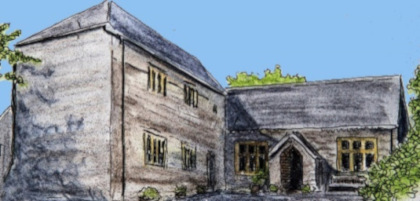
MANOR
HALL TRUST
All being well, by the time you are reading this Newsletter
the refurbishment to the hall floor will be well underway and fingers crossed
the contractors have not found anything that will extend the works.
Thank you to John and Fenella for allowing us to use their
barn for chair storage whilst the work is being carried out.
Our final fundraiser in the hall before the closure was a
great success and the Acorns entertained us excellently, and we are extremely
grateful to them for doing this for free.
Once again, a huge thank you must go to
Wendy [and Colin, of course] and all her team who did another fantastic job of
making and serving a delicious supper - thank you all very much. The evening raised a terrific £909.
Further fundraisers are being planned for the spring and summer.
We have decided not to go ahead with a Mr.
& Mrs. Night as it was thought this might incur some unpleasant divorce
proceedings, which in turn could mean a sudden surge in For Sale signs around
the village!
Any ideas for fundraisers
and or activities that you think might be good to do in the hall would be
gratefully received.
Happy Easter!
Julia
Chairman: Julia Fairchild [882783] Bookings:
Alison Sharples [882782]
12

WEATHER OR NOT
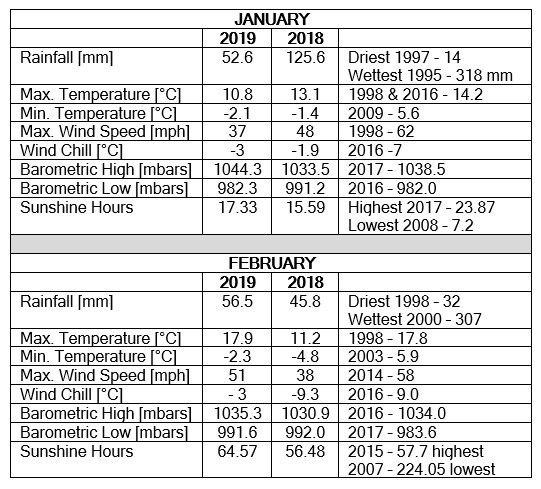
What an amazing start to 2019. I think everyone has been surprised by the
weather during February - the plants and wildlife must be very confused by the
sunshine and high temperatures. For
January and February, I am going to give you direct comparisons with 2018,
together with another figure from my records.
January was a fairly stable month with
nothing much happening apart from some sharp frosts on the 9th and 10th at -3°C,
-2.4°C on the 30th and -2.7°C on the 31st.
February started off with frosts on 5 days and then along
came storm Eric producing 15.3 mm rain and a top wind speed of 51mpt. By the 11th the weather improved with only
49.5 mm of rain up to the 18th. We then
had no rainfall until the 28th when 7mm fell, making the total 56.5mm.
I feel sure that we'll suffer from having had this good
spell and I hear on the forecast that we have storm Freya on the way. I have no doubt there will be more about
that in the next edition!
Simon
13

NEWS FROM THE PRIMARY SCHOOL
We are writing this on World Book Day. This year our theme has been Detectives. A very talented member of staff wrote a
mystery story for the children and they have spent the day using their
inference skills to solve the mystery.
We won! Thank you again to everyone that supported
the Tesco Bags of Help. The school
scooped £4000 towards our playground renovations! We are currently collating prices and are
hoping to begin work in the summer holidays.
It will be a tricky job due to limited access, but we are hopeful we can
get it done. Watch this space for
photos.
The School Choir have had a busy start to the spring
term. Their first event was a very
successful evening alongside Beaford Arts and the Village Choir. The Manor Hall was full to capacity!
On Saturday, 2nd March, forty-eight children from across the
Federation performed at Exeter Cathedral.
This was part of the Chorister Outreach Project for KS2 children and involved
other local schools and the Devon County Youth Choir. It was truly an amazing experience and a
privilege to sing in such a stunning setting.
The children made us extremely proud!
Here are some quotes on the performance:
- What a brilliant
performance by our choir - outstanding achievement.
- Thank you, Christina, for all your
skill in pulling this off, and to everyone else who, in one way or another
supported this project.
- Christina,
the children were a delight to watch and made me [and I am sure everyone else]
very proud. Thank you so much for
giving them this fabulous opportunity and for all your efforts in bringing it
all together.
- I just wanted to tell you how
exceptionally proud I was of the children, school and Mrs. Barrow today - the
kids were outstanding. Thank you so much
for enabling them to access music for free and in school. But real thanks to Christina who is
obviously doing some amazing stuff.
Aspen
Class also took part in an exciting Composition Workshop with the North Devon
Sinfonia and composed music to their limericks.
Our Summer Term is always a busy one! Our Year 5 and 6 pupils will have their SATS
tests. It can be a very stressful
time, but they will be very well prepared and we are sure that they will all do
amazingly.
We have our school production in the Theatre. The children really rise to the occasion of
performing on stage and to a large audience.
They never fail to impress and always pull off an amazing show! Tickets will be available from the School
Office at the end of June.
Alongside this we also have a Residential, Sports Day and
various sporting events. The children,
and staff, are always ready for the summer holidays!
A date for your diary: PTFA
Summer Fayre - Friday 5th July. Look out
for posters for more information nearer the time.
We would like to wish everyone a very Happy Easter.
Sue
Carey - Headteacher
15

16

NEWS
FROM BERRYNARBOR PRE-SCHOOL
A
First Taste in Learning
Our Topic
of Learning
We have had a busy Spring Term focusing on
Maths: counting, recognising numbers and
learning about the names and properties of shapes.
Our children created a shoe shop and
enjoyed many hours in role play trying on shoes and buying them. Other activities included sorting and pairing
up shoes, slippers and sandals and putting them into boxes. Our Pre-school
elves kept a close eye on the children to ensure all the jobs were done well!
After singing many number songs, our shoe
shop was converted into a bakery where the children made and sold current buns.
These were also recreated in an actual
cooking activity and the smell of cooking cakes filled the Manor Hall! The children also made their own pizzas,
choosing their own topping and cutting them into slices.
With some help, the children created a
display of a Shape Train. We put a different shape on each carriage and
the children chose which shape they liked. Tickets were sold and many adventures
started.
School
Visits
We all enjoyed our school visits and had a
lovely time learning about the weather and exploring all the different
resources and activities. Thank you,
Mrs. Wellings, and to all the children who looked after us and its lovely to
see how well you have all settled at school.
Events
We celebrated World Book Day reading many
rhyming books and stories. We also
wore something red and took part in a Red Nose Day event raising a few pennies
for this charity.
We should like to thank Be and Richard
Gingell for their kind donation after another successful Soup & Pud Evening.
This money is going towards much needed
storage boxes for the children's toys.
We have booked our next Bags2School
collection on Thursday,
2nd May.
Bags will be available at Pre-school
and in the Community Shop and Post office. They will take any unwanted clothes, bags,
paired shoes, belts and bedding. Unfortunately, they will not take uniforms or
duvets [filled items]. Please have a
spring clean and start sorting out your wardrobes and drawers for any unwanted
clothes and help us raise some money for our Pre-school. Bags can be dropped off at Pre-school in the week
starting 29th April. Thank you for your support.
From the
staff at the Pre-school
as well
as Laura, Tina and Kirsty on the Committee
17
THE BILTONS
A basically true story
It was during World War I that the
Biltons moved into a house on Hagginton Hill.
Willy, who was British, had married a woman of German origin, who
became, due to the marriage British as well.
Will and Wilhelmina settled well in
Berrynarbor and involved themselves in village activities. They would help with sorting the waste paper
salvage and Willy joined the village drama group, performing in short plays by
Mabel Constanduros and Howard Agg.
Unfortunately, the Biltons had put
money into shares in companies in Czechoslovakia, which sadly produced no
return. This meant them living on their
capital which eventually ran out.
Money-wise things began to get very
difficult for them and they began to sell some of the household goods, such as
cutlery, crockery, etc.
In time, with nothing much to sell and
in desperation they took money from the church box. However, they were seen doing this and were
expected to be taken to court.
In shame, they went to Woolacombe where
together they waded out to sea and drowned.
Tony Beauclerk -
Stowmarket
Mabel Constanduros
Born on
the 29th March 1880, Mabel was one of seven children of Richard Tilling, the
managing director of the Thomas Tilling bus Company and his wife Sophie. An English actress and screenwriter, she
trained at the Central School of Speech Training based at the Royal Albert
Hall, London, making her stage debut at the London Coliseum in 1929,
subsequently playing a variety of roles in London and on tour.
She
became more well-known playing Mrs.
Buggins on the radio programme The Buggins Family, which ran from 1928 -
1948. As well as writing the series,
she began by playing the whole family.
She also wrote novels and short stories. After World War II, she played earthy
Mangold in the popular Worzel Gummidge radio series on BBC Children's Hour.
She married Athanasius Constanduros, who
died in 1937. They had 3 children but
only one, their son Michael, survived to adulthood. Mabel died in 1957 in Chichester, Sussex.
Howard Agg was a
playwright, author and BBC radio journalist.
He was born in 1908 and died in Sicily in 1968.
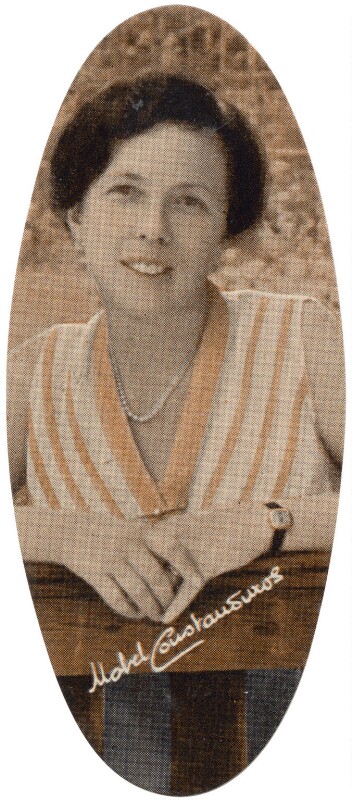
Mabel Constanduros (née Tilling)
by Unknown photographer, issued by Carreras Tobacco Company
colour relief halftone cigarette card, 1935
NPG D49334
© National Portrait Gallery, London
Licenced under CC BY-NC-ND 3.0
18

KNIT & NATTER

Thanks to the good folks who turned up
at the Manor Hall with their knitting needles and wool, who took part in the
raffle and enjoyed tea and cakes, the Knit and Natter on the 25th February was
another successful afternoon. The North
Devon Hospice will benefit by a donation of £200 and four bags of brightly
coloured strips ready for sewing together to make multicoloured blankets. Thank you, all knitters!

It was good, once again, to be able to
welcome Ali Hunt from the Hospice who joined us, and not only did she tell us
of the current happenings at Deer Park, she set to and helped make the tea and
washed up! Thanks Ali.
The Hospice Knit and Natter has been
running for some years but the first time the village participated was in
February 2005, in conjunction with Sally Barten's Sunday School Pancake
Morning. Knitters organised sponsorship
which raised a great sum of £603, and Ali joined us for the first time! Knit In's, with Pancakes, followed for the
next two years, raising a further £1,300 for the Hospice.
As a
consequence of the first Knit In, when someone said "This is fun, we should do
it more often", the Monday afternoon Craft Group was formed, running
successfully ever since. Knit In's,
although sadly without pancakes, have also continued but rather than raising
money through sponsorship - it was felt that asking the same sponsors yet again
didn't seem right - a minimum donation of £5.00 was introduced and this
continues today, with well over £4,000 being raised over the years.
The craft group has enjoyed outings and
Christmas lunches together and last year visited Wells Cathedral, where the
Cathedral cat, Pangur, could be seen snoozing on his red carpet, and the
Bishop's Palace.
Why not come and enjoy a relaxing
afternoon with friends and refreshments and help decide to where the next trip
will be?
19
PANGUR BÁN
A horrible, definitely 'stay in' wet
morning and I began to wonder why the vergers at Wells Cathedral had named the
cat Pangur. Looking into this, I found
the research took some interesting and personal twists.
About the cat himself. In 2014, the BBC reported, "A turf war looks
set to break out at Wells Cathedral, where the resident tom cat, ginger Louis,
is facing competition from a tabby interloper."

Pangur

Louis

Tiddles
One of
the most photographed features of the Cathedral, Louis, who had been adopted
there in 2004, ten years earlier, was said to be unimpressed by the interloper,
who had taken not only to roaming the pews and sitting in front of the altar
during services, but also preferred stealing Louis' food to eating at his
nearby home. Since Louis retired to a
loving home in 2017, at the age of 20, Pangur has ruled the roost.

St Mary's Church, Fairford
Apparently
over 40 cathedrals in the UK claim to have cats as their mascots and mouse
deterrents. Cat lovers, if you have not
come across them yet, there is a delightful set of small books of photographs
of cats by Richard Surman - Cathedral Cats, Church Cats, Cloister Cats and
County House Cats.
Thinking of church cats reminded me of
a visit to St. Mary's Church at Fairford in Gloucestershire. There, in the churchyard close to the main
door is a headstone for Tiddles, who was the cat that 'kept the mice in check'
there from 1963 to 1980, and the headstone marks the place where he was buried.
St. Mary's is also fascinating and
deserves a visit if you are ever in that area.
In 1490, the church was rebuilt on the site of an earlier medieval one
by John Tame, a wealthy wool merchant, and the original 14th century tower was
retained and the new church built round it.
The bells, therefore, are unusually located in the middle of the church.
However,
the church is more renowned for containing the finest complete set of 28
medieval stained-glass windows in England.
But back to Pangur Bán, an old Irish
poem written by an Irish monk, about his cat, around the 9th century at or
around Reichenau Abbey. Bán means white
and pangur a fuller, from fulling cloth.
There have been several translations of
the poem into English, two of which are by W.H. Auden and Seamus
Heaney.
Pangur, white Pangur, How happy we are
Alone together, scholar and cat,
Each has his own work to do daily;
For you it is hunting, for me study.
Your shining eye watches the wall;
My feeble eye is fixed on a book.
You rejoice when my mind fathoms a problem.
Pleased with his own art, neither hinders the other;
Thus we live ever without tedium and envy.
W.H. Auden

Great West Window, St. Mary's Church - The Last Judgement
Pangur Bán and I at work,
Adepts, equals, cat and clerk:
His whole instinct is to hunt,
Mine to free the meaning pent.
More than loud acclaim, I love
Books, silence, thought, my alcove.
Happy for me, Pangur Bán
Child-plays round some mouse's den.
Truth to tell, just being here,
Housed alone, housed together,
Adds up to its own reward:
Concentration, stealthy art.
Next thing an unwary mouse
Bares his flank: Pangur pounces.
Next thing lines that held and held
Meaning back begin to yield.
All the while, his round bright eye
Fixes on the wall, while I
Focus my less piercing gaze
On the challenge of the page.
With his unsheathed, perfect nails
Pangur springs, exults and kills.
When the longed-for, difficult
Answers come, I too exult.
So it goes. To each his own.
No vying. No vexation.
Taking pleasure, taking pains,
Kindred spirits, veterans.
Day and night, soft purr, soft pad,
Pangur Bán has learned his trade.
Day and night, my own hard work
Solves the cruxes, makes a mark.
.jpg)
Reichenau Abbey
©Hilarmont (Kempten), CC BY-SA 3.0 DE, via Wikimedia Commons
Seamus Heaney
The original poem, in eight verses of four lines, is
preserved in the Reichenau Primer in the Library of St. Paul's Abbey in the
Lavanttal, Austria. the Benedictine
abbey of Reichenau was founded in 724 by the itinerant St. Pirmin who is said
to have fled Spain ahead of the Moorish invasion. It is situated on Reichenau Island, an
island in Lake Constance in southern Germany.
Connected to the mainland by a causeway, and because of the Abbey, the
island was declared a World Heritage Site in 2000.
Today, the island is also famous for its vegetable farms and the nearby large nature reserve, a wetland area of reeds visited by many birds as a stopover during their annual migration.
Judie Weedon
20
LOCAL WALK - 173
James Ravilious: "showing North Devon people to themselves"
You may have seen the work of
photographer James Ravilious featured on television on Countryfile recently.
In 1972 John Lane, the founder of
Beaford Arts, had commissioned James Ravilious to "show north Devon people to
themselves" and eventually this resulted in an archive of seventy thousand
photographs depicting farming and rural life, landscape and weather taken
throughout the 1970's and '80's.

Seven years ago, the Devon Wildlife
Trust and Beaford Arts devised a walking trail around Halsdon Nature Reserve
near Dolton [south of Torrington] to explore some of the countryside
photographed by Ravilious.
The circular route of about five and a
half miles passes through woodland and meadows, alongside a section of the
River Torridge and includes the specific locations of some of his photographs.

Halsdon Reserve
Illustrations by: Paul Swailes
A booklet, Dolton as seen by James
Ravilious, produced by Beaford Arts, has a map showing the route and
incorporated several of the photographs.
The walk can be accessed at the north entrance to the nature reserve at
Ashwell where there is parking or at Quarry Car Park at the south entrance.
James was the son of Eric Ravilious
most famous for his delicate and rather mysterious water colour
landscapes. James also started as a
painter and taught art in London, later turning to photography when he felt his
own paintings were beginning to look too much like his father's!
James Ravilious died in 1999 and from
the vast archive [which is housed in the Devon Records Office] he considered
seventeen hundred to be his best.
However, at Bideford's Burton Gallery there is to be an exhibition of
many previously unseen Ravilious photographs, displayed for the first time.
The exhibition entitled "Here:
Uncovering North Devon", runs from the 4th May until the 23rd June. Meanwhile, we can explore a sample of the
countryside he celebrated with a walk around Halsdon Reserve.
Sue H
21
JAMES RAVILIOUS
James was born in Eastbourne on the
22nd August 1939, the second son of the war artist, wood engraver, and
neo-romantic artist Eric Ravilious and his wife, the artist Tirzah Garwood.
The only memory James had of his father
was on the day Eric left for Iceland, 'was of running down the lane that summer
morning to say good-bye to him and his father hugging him and giving him a
threepenny bit!' In 1942, when James
was three, Eric took off from an airfield in Iceland, but the plane never
returned. Sadly, his mother died of
cancer when he was 11.


James with his mother, brother John and sister Anne
After attending Bedford School, James
studied accountancy but felt that this was not the career for him and in 1959
he enrolled at St. Martin's School of Art in London, which was followed by
seven years teaching at Hammersmith College.
In 1970 he married [Caroline] Robin
Whistler and in 1972 they moved to Devon to live in a cottage near her
family home in in Dolton. They had two
children, Ben and Ella.
Self-taught, in the early '70's, James
took up photography, having seen the potential in the work of the great French
photographer, Henri Cartier-Bresson, and the realisation that his painting was
becoming too similar to that of his late father.
John Lane, director of the arts centre
in Beaford, invited James to contribute some work to the newly set up Beaford
Archive, intended as a photographic record of life in a largely unspoilt but
vulnerable country area. What started
as a short-term project grew into a 17-year obsession, during which time James
took over 70,000 black and white images of all aspects of local life -
landscapes, farming, everyday life in local towns and villages and their
special occasions.

The resulting historical span and
detail makes it probably the most intensive record of any rural area in
England. But it is more than that. James's pictures were never posed but
composed with the eye of an artist and they capture subtle qualities of light,
and are enhanced by his affection and admiration for the people whose lives he recorded. They reveal life as it was being lived in
20th century rural England when many country
traditions that had been passed down through the ages, were still part of
everyday life. James also undertook
private commissions and photographed in France, particularly Normandy, Italy,
Greece and Ireland
and other parts of the British Isles.
His work has been exhibited in England,
France and America and he published a number of books of photographs. In 1977 he was given Honorary Membership of the Royal Photographic
Society in recognition of his contribution to photography.
James died of lymphoma in Barnstaple on the 29th
September 1999 at the age of 60.

Chalk Paths by Eric Ravilious 1903-1942
For more information on James' work, see: www.jamesravilious.com
Here: Uncovering North Devon
Burton at
Bideford, 4th May to 23rd June 2019
Opening Times:
Monday to Saturday 10.00 a.m. to
4.00 p.m.
Sunday 11.00
a.m. to 4.00 p.m.
The Beaford Archive is an extraordinary
collection of material about North Devon which dates back to 1890. It is best known for its photographs by James
Ravilious and it was one of the first commissions taken on by Roger Deakins,
now an Oscar-winning cinematographer.
As part of a huge Heritage Lottery-funded
project, Beaford has been digitising and revealing thousands of previously
unseen images. Through interviews with people connected to the photographs,
projects with primary school children and public workshops and events, Beaford
has asked people what the Archive means to them.
In this exhibition, those who live and
work in North Devon give their unique take on the Archive and the deep
connections it inspires, human stories it uncovers and the future
considerations it provokes.
You'll be able to explore the photographs,
listen to the voices of local people and view new artworks inspired by the
Archive.
You'll also discover how its themes impact
the lives of people living in North Devon now, and you can add your own
responses in order to help shape the Archive.
To
accompany the exhibition, there will be a number of talks, discussions and
workshops. Keep an eye on our social media and the Beaford website for full listings.

22
A
HISTORY OF BERRYNARBOR SCHOOL - 2
In the last Newsletter I outlined my research into the
history of the village school and gave a short description of the first
logbook. Three of these Head Teacher's
logbooks have survived and the first one, which begins in 1874, starts with the
words "School re-opened. . .". So, the
school was already operational by 1874 and, of course, there is a plaque on the
front of the school bearing the date 1847.
This immediately raises several questions: were there earlier log books and if so, what
happened to them? What can we find out
about the school between 1847 and 1874?
And was there a village school before 1847?

The
plaque on the front of Berrynarbor School: 'National School 1847'
Keeping a log book was regulation for all grant-aided
schools from 1862, so it is likely that there was at least one earlier logbook,
but it is probably lost. To try and
find out about the school teachers, I turned to the census returns. The first census was in 1841 and
unfortunately does not include people's professions, but in 1851 there were
three teachers living in the village - and they were all related. Ann Hicks is described as a 'School
Mistress', although since she was 80 years-old she may have retired. George Hicks, 'School Master &
Engraver', was 44 years old and lived with Ann and was probably her son or
nephew. Their address is simply given
as 'Village'. Prudence Griffiths, a
'School Mistress', was 39 years old and lived with her family at Court Cottage,
she was the daughter of Ann Hicks and perhaps the sister of George. It seems likely that George and Prudence
were teachers at Berrynarbor School, probably with George teaching the older
children and Prudence the infants. It
is interesting that both Ann and Prudence were married women who apparently
worked. Prudence had four children at
home in 1851, one of whom was of pre-school age and would have required care. By 1861 Ann had died and Prudence and George
appear to have moved out of the village.
There is a teacher on the 1861 census, Priscilla Griffield, a single
woman of 23 who had been born in Wales, but I have been unable to find out
anything more about her. Her name is quite similar to 'Prudence Griffiths', but
Prudence was older, married and living in Ilfracombe in 1861.
Trade directories are another useful source of information
about people at this time. Kelly's Directory of 1850 lists 'Geo Hicks' as the
village schoolmaster, thereby backing up the 1851 census. White's Directory of
1850 lists both Geo Hicks and Mr. James Geer as school teachers at Berrynarbor.
There was just one adult named James Gear living in the area in 1851 and he was
a farmer living with his family at South Lee and farming just 3 acres. He was
born in Berrynarbor and lived there for most of his life but there is no
mention of him being a teacher. The Kelly's Directory of 1866 lists William
Harding as schoolmaster and Mrs. Jane Hicks as schoolmistress; the name Hicks
again and another married woman. There was just one Jane Hicks in the village
in 1861, the wife of stone mason James Hicks, but there is nothing to say she
was a teacher. No teacher named William Harding appears on the 1861 census for
Berrynarbor, but there was one in Ilfracombe and it is likely that this is him.
Since teachers generally lived close to the school, he probably moved to
Berrynarbor sometime after 1861 to take up the position.
This leaves the question of whether there was a school
before 1847. The online catalogue for the National Archives at Kew shows they
hold a document about the building of Berrynarbor School in 1847.
At the beginning of this year I went to have a look; this is the first time I have visited the
Archives and it was a very interesting experience. I did not know how much information the
document would contain, or what form it would take. When I arrived, I was given a large volume
entitled 'School Building Grants. Certificates &c.' It proved to be full of application forms
for grants to build schools all over the country - and it didn't appear to be
in any particular order so I thought I might be there for quite a while.
However, I struck lucky and found Berrynarbor quite quickly. The application
was on a printed form and had been filled out by the village Rector, Samuel
Thomas Gully, and dated the 20th February 1847. There are details about the building site
chosen for the school, its design and the funds already raised, but more about
these aspects another time. In answer
to the question about existing schools in the village, Reverend Gully says "[there
are] two Dame Schools, in each of which, being about 12 feet? 50 children are
crowded". Unfortunately, the word
after the number 12 feet has disappeared into the binding of the book, perhaps
it said 'square', however it is hard to
imagine so many children in one room!
He also adds that "the Sunday School consisting of 150 children, are
taught in the Church, there being no other accommodation."
So we now know that in 1847 there were actually two schools
in the village. These were 'dame
schools', the earliest schools for the poor and generally held in the teacher's
home - hence the cramped conditions.
There are no details about the location of these schools or
the teachers, but traditionally such
schools were taught by elderly women, hence the name. Perhaps School Mistress Ann Hicks, who would
have been about 76 in 1847, was one of these teachers and encouraged her own
children to follow in her profession.
Reverend Gully was successful with his application and the
school must have been built quickly since the plaque on the wall says 1847.
Arthur Davie Bassett of Watermouth, described in the document as 'Lord of the
Manor', provided the site for the school.
The Reverend Gully put forward £10 of his own money towards the fund and
claimed they could raise another £10 by subscriptions. The sum requested in the grant application
was for £130.
Tanya
Walls
March
2019
23
MEMORIES
The young lady who is researching the
Berry School records, hopefully will produce a book.
I was at school there in the days of
Miss Lilian Veale [headmistress], Miss Muriel Richards in Primary class from 1944
to Mrs. Cowperthwaite 1951. Mr.
Cowperthwaite, a teacher at Combe Martin Sec. Modern School at Seaside, took us
for History and Maths.
I enjoyed the old photos of Pitt Hill,
in particular the cottage where a lady called Miss Ivy Nichols lived. She always wore a maroon coloured coat,
1930's style, with a fur wrap around her shoulders of an animal that had a
beady eye. She used a stick at the
older boys as they taunted her, but I thought she was a kind soul - Gran said
she was a recluse. Sometimes she
wouldn't speak at all - I've never forgotten her and the beady eyes of the fur
stole - 70 plus years ago!
Another photo of below her cottage was
with an article of the School Attendance Officer who would visit to investigate
if a child was not at school. It
brought back memories of Mr. Major calling on my Gran when I had been kept home
with rheumatic fever and childhood ailments in the days before the NHS.
How the country folk lived before
antibiotics - every home seemed to have a high-backed wooden armchair beside
the cooking iron range and where the eldest member of the family would be
dozing, 40 winks - before the days of care homes, and hospitals were for people
who could pay. I remember the Hospital
Aid that Gran used to pay so much a week to Mrs.
Brooks [mother of Jimmy Brooks] she had a wheelchair.
Sheila Twose -
Torquay
24
Paul, our
Artist in Residence, will be exhibiting his work at his home, 10 Montpelier
Terrace, EX34 9E in the Ilfracombe Art Trail, which takes place on Saturday
11th and Sunday, 12th May, 2019, from 10.30 a.m. to 6.00 p.m. Paul's wife, Chris, will also be exhibiting
her quilting.
In
its 5th year, the 2019 Open Studios Art Trail sees over 60 local artists
exhibiting a wide range of work across 40 venues around the town of Ilfracombe.

25

CHILDHOOD LITERATURE
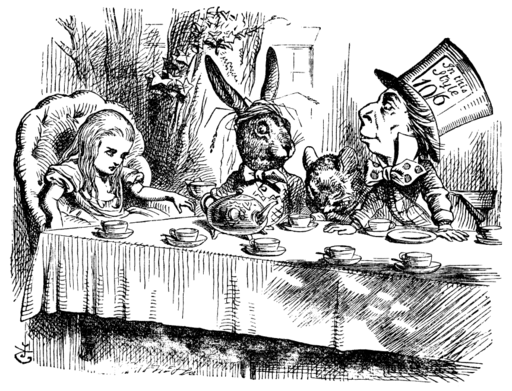
"Alice in Wonderland" illustration
by John Tenniel, Public domain, via Wikimedia Commons
"Oh, you can't help that," said the Cat, "we're all mad here. I'm mad, you're mad."
"How do you know I'm mad?" said Alice.
"You must be," said the Cat, "or you wouldn't have come here."

Cheshire Cat - by John Tenniel
Public domain, via Wikimedia Commons
In July 1862,
the author Lewis Carroll and the Rev. Robinson Duckworth rowed up the Isis from
Oxford with the three young daughters of the Vice-Chancellor of Oxford
University and Dean of Christ Church, Henry Liddell - Lorina [13], Alice [10] and Edith [8]. During the trip he told the girls a story
about a bored little girl named Alice who went looking for adventures. Captivated by the story, Alice asked him to
write it down for her. Alice's
Adventures in Wonderland came into being and was published three years later in
1865, with illustrations by John Tenniel.

Lewis Carroll
by Hills & Saunders
albumen print, 1860s
Given by Graham Ovenden, before 1977
NPG x5181
© National Portrait Gallery, London
Licenced under CC BY-NC-ND 3.0
Alice in
Wonderland, as it is known, was followed in 1871 by Through the Looking Glass
and what Alice found There. The tales
of Alice have appeared on stage and screen many times, two of which are the
American musical fantasy of Walt Disney in 1951, and the 2010 film directed by Tim Burton with an all-star cast including Johnny Depp as the
Mad Hatter, Mia Wasikowska as Alice, Anne Hathaway and Helena Bonham Carter as
the White and Red Queens, the late Alan Rickman as the Caterpillar, Michael
Sheen the White Rabbit, Barbara Windsor the sleepy Dormouse and Stephen Fry
grinning as the Cheshire Cat.
The tale takes
Alice into a fantasy world populated by humans and strange anthropomorphic
creatures, The story and its lasting
poplularity, with adults and children, is considered to be one of the best
examples of literary nonsense, the characters and imagery influential in both
popular culture and lieterature, especially in the fantasy genre.

Alice Liddell
by Lewis Carroll
albumen print, July 1860
Purchased jointly with the National Science and Media Museum, Bradford, with help from the Art Fund and the National Heritage Memorial Fund, 2002
NPG P991(8)
© National Portrait Gallery, London
Licenced under CC BY-NC-ND 3.0
Charles Lutwidge Dodgson, known by his
pseudonym as Lewis Carroll, was born in the parsonage at Daresbury, Cheshire,
on the 27th January, 1832, the eldest boy of 11 children, a high church
Anglican family. His father, Charles
Dodgson, a gifted mathematician, took holy orders but became a country parson, marrying
his cousin Frances Jane Lutwidge.
The young Charles, who suffered from a
stammer, a condition shared by most of his siblings and one he found
debilitating all his life although he found it easier communicating with
children, was also a gifted mathematician.
He was initially educated at home, going to Richmond School in Yorkshire
when he was 12 and then on to Rugby School, where he was very unhappy. Being tall and slender, with a weak chest
caused by a severe childhood attack of whooping cough and a stammer, he was
possibly bullied.
He went on to Christ Church, Oxford,
and in 1852 was awarded the equivalent of a scholarship, took up residency
there and in 1854 awarded First
Class Honours in the Final Honours School of Mathematics. He was appointed a Lecturer in Mathematics.
Despite his growing wealth and fame,
little changed during the last twenty years of his life. He continued to teach at Christ Church until
1881 and remained in residence there until his death.
His social circle amongst others
included John Ruskin, Dante Gabriel Rossetti, William Holman Hunt and
Millais. Apart from his literary
success, Dodgson was an accomplished photographer with notable portraits of
Ellen Terry and Alfred Lord Tennyson.
He also photographed children, finding himself vocally fluent when
speaking to children
and entertaining them, enjoying their company and creating stories for
them. Despite conjecture, there is
little evidence of there being anything improper in his behaviour toward them.
Lacking in good health throughout his
life, suffering from migraine, epilepsy and micropsia [optical distortion] just
before his 66th birthday he contracted 'flu which turned to pneumonia, dying at
his sister's home in Guildford on the 14th January 1898. His funeral was held at the nearby church
of St. Mary and he is buried in Guildford at the Mount Cemetery.
By the time of his death, Alice and her
adventures had become one of the most popular children's books in England and
by 1932, one of the most popular in the world.
Judie Weedon
26

RURAL REFLECTIONS - 87
I remember as a young child how
the month of May was pivotal in our football-crazy family, for it held a
Saturday with a three o'clock whistle that heralded the kick-off of the FA Cup
Final. It was a match that back then
was a rarity in being televised live and having a build-up, albeit interrupted,
on either Grandstand or World of Sport.
Oh, how times have changed! Now, football's season eats well into that of
cricket. Likewise, county cricket has
expanded its span of play. This year the County Championship will start just
after this issue goes to press, on the 5th April, and finish on the 26th
September. Like England's international
calendar, the powers-that-be are also trying to pack in as many county matches
as is realistically possible; a good
job, therefore, that teams no longer play on uncovered pitches which could be unpredictable
even during cricket's native summer.
The other day, whilst contemplating these thoughts, I was
reminded of the story of Alfred
Lyttleton. Born in 1857 he was later to
become a member of Parliament for the Liberal Unionist Party and brother-in-law
to the Prime Minster, Arthur Balfour.
The youngest of eight brothers, Lyttleton was born into a family that
excelled at sports. However, he would
go on to supersede them by becoming arguably one of the most prominent
sportsmen of his time. Among other
sports, he became a distinguished footballer and cricketer, playing for England
in both arenas. But it was whilst competing in a cricket club match against
Bethnal Green Tradesmen that, having made 89 runs, a blow from a ball caused an
internal abscess. Recuperating in his
hospital bed after an emergency operation, he was visited by one of his
brothers. "Don't let them make too
much fuss of the cricket ball," Lyttleton whispered into his brother's
ear. "Just a piece of bad luck."



Illustrations by: Paul
Swailes
One cannot compare Lyttleton's take on the incident to that
of a lady who tripped and fell whilst shopping in her local town centre. Thankfully able to get herself up and walk
back to her car she was soon, however, experiencing severe leg pain and was
barely able to weight bear. Fearing the
worst, she decided to take herself to the A&E department, but not before
taking a detour so as to return to the scene of her fall. Unsure though she was as to whether a raised
surface had actually caused her to trip, she hoped all the same to find as much
so she could take a photograph and subsequently sue the council for damages and
get compensation. Again, how times have
changed.
Indeed, when I entered the workforce in the 1980's the term
"risk assessment" was far from common knowledge. That's not to denounce Health and Safety, for
life in the working environment is far safer than it was once. I may be going back in time, but I should
not have wanted, for example, to have been a navvy involved in the construction
of the Great Western Railway network, or any other line come to that. Severe injuries and fatalities are well
documented. However, whilst such facts
justify the safer environment in which we live, others would argue that Health
and Safety have gone too far; and it is here that I draw a parallel with trees.
I tend to place the lifespan of trees into one of three
categories. There are those that are felled for a useful purpose; for example, for timber or for the creation
of copses or for natural regeneration or, arguably, the provision of
housing. Then there are those that are
taken out as a result of being on land used by the general public and deemed
dangerous by risk assessment. To what extent the tree may be unsafe is
often open to debate; some will argue that the decision maker is being over
cautious for fear of an accident and subsequent costly compensation. Finally, there are trees, usually on private
land, that are allowed to live out their natural lifespan. In their twilight years, such trees
encounter storms that will snap off a few more branches and create in the
process a wizen appearance far removed from the tree's attractive and seemingly
symmetrical outline that it once boasted.
Bored from the inside out by either beetles, wasps or moths, its trunk
eventually lacks the strength to hold up its outer carcass and caves in. Insects and natural degeneration then ensure
that the tree returns to the soil from which it once grew.
So, as spring progresses and our deciduous trees come into
leaf once more, be sure to give reverence to the lone naked and crooked tree in
the field for it is doing its bit for the natural environment. Indeed, through its death it is providing new
life. Happy Easter.
Stephen
McCarthy
27
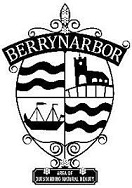
FROM THE PARISH COUNCIL
Berrynarbor Parish Council
Chairman - Adam Stanbury [882252]
Gemma Bacon [883341]
gemmabacon@berrynarborparishcouncil.org.uk
Jenny Beer
jennybeer@berrynarborparishcouncil.org.uk
Julia Fairchild [882783]
juliefairchild@berrynarborparishcouncil.org.uk
Denny Reynolds
dennyreynolds@berrynarborparishcouncil.org.uk
Vice-Chairman - Sian Barten [882222]
sianbarten@berrynarborparishcouncil.org.uk
Adrian Coppin [882647]
adriancoppin@berrynarborparishcouncil.org.uk
David Kennedy [07791 781283]
davidkennedy@berrynarborparishcouncil.org.uk
Clare White [882959]
clarewhite@berrynarborparishcouncil.org.uk
Parish Clerk - Victoria Woodhouse - clerk@berrynarborparishcouncil.org.uk
County Councillor - Andrea Davis [883865]
District Councillors - Yvette Gubb [882364], John Lovering [john.lovering@northdevon.gov.uk]
Snow Warden - Clive Richards [883406]
Adoption of the Public Toilets and a Lease for the Car
Park - Update:
Following
the public consultation held in January, the Parish Council considered the
adoption of the public toilets and a lease on the car park in the village at
its full Council meeting in February 2019.
There was a large amount of
community support to pursue the proposals, subject to clarification of some of
the details and liabilities which may be placed on the Parish Council. The
Council has therefore agreed, in principle, to adopt the toilets and lease the
car park and to continue negotiations with the North Devon Council. These negotiations are still in the infant
stage and the Council will continue to update the community through the Newsletter,
Website and Parish Council meetings.
The
Parish Council has been asked by the North Devon Council to consider any
updates to its 121 list. This is a list
of community projects that can be included in legal agreements for Section 106
money [where appropriate], relating to developments. If
there are any projects you would like to see included in this list, please let
the Parish Council know.
Berrynarbor
Parish Council holds the Foundation Level of the Local Council Award Scheme
which highlights that, not only does the Council meet the requirements for
operating lawfully, it also goes beyond its legal obligations, leading its
community and continuously seeking opportunities to improve and develop
further. The achievement confirms that Berrynarbor Parish Council achieves
good practice in governance, community engagement and council improvement. To
build on this award the Parish Council has agreed to work towards and apply for
the Quality award which is the next level, the aim is to apply following the
May 2019 elections.
Elections: Parish Council elections are due to take
place on Thursday, 2nd May 2019. If you are interested in becoming a
Councillor, a nomination pack can be obtained from the Parish Clerk or from the
Returning Officer at the North Devon Council, Lynton House, Commercial Road,
Barnstaple. Completed nomination papers must be returned
to the Returning Officer between 10.00 a.m. and 4.00 p.m. and no later than 4.00
p.m. on Wednesday 4th April 2019.
Finally, I shall be commencing Maternity Leave shortly. Mrs Kate Graddock will be providing cover during this time and will commence with the Parish Council on the 1st April 2019 to allow a handover and induction period. Mrs Graddock can be contacted via the Clerk's email address clerk@berrynarborparishcouncil.org.uk or on 07703 050496.
Vicki Woodhouse - Parish Clerk
Our best wishes go to both Vicki and
Kate during the time of Vicki's Maternity Leave.
28
AT-A-GLANCE DIARY
| MARCH | |
| 31st | British Summer Time begins, 1.00 a.m. St. Peter's Church: Mothering Sunday Service, 11.00 a.m. |
|---|---|
| APRIL | |
| 5th | Ilfracombe Academy and Primary School: End of Spring Term |
| 14th | St. Peter's Church: Palm Sunday, 11.00 a.m. Palm Crosses |
| 17th | Wine Circle, 8.00 p.m. Manor Hall: Nigel Pound, Totnes Wine |
| 19th | Good Friday St. Peter's Church: Hour of Devotion, 2.00 p.m. |
| 21st | Easter Sunday St. Peter's Church: Easter Service, 11.00 a.m. |
| and 22nd | Marwood Hill Gardens, Easter Trail |
| 23rd | Ilfracombe Academy & Primary School: Start of Summer Term Mobile Library in Village from 11.40 a.m. |
| 24th | Friendship Lunch, The Globe, 12.30 p.m. |
| MAY | |
| 4th | to 23rd June Burton at Bideford - Here: Uncovering North Devon Exhibition |
| 13th | St. Peter's Church: Installation of Rev. Peter Churcher, Pip & Jim's, Ilfracombe, 7.00 p.m. |
| 15th | Wine Circle, 8.00 p.m. Manor Hall: A.G.M. |
| 19th | St. Peter's Church: Joint Service at Pip 7 Jim's, 10.30 a.m. Great Berrynarbor Plant Sale: Plants from 11.00 a.m. Doors open at 2.00 p.m. |
| 21st | Mobile Library in Village from 11.40 a.m. |
| 29th | Friendship Lunch, The Globe, 12.30 p.m. |
| Manor Hall Diary | |
| Mondays | Upholstery, 9.00 to 1.00 p.m.Craft Group, 1.45 p.m. Badminton, 7.30 p.m. |
|---|---|
| Tuesdays | N.D. Spinners [2nd & 4th] 1st and 3rd: Craft Art Group, 9.30 a.m. |
| Wednesdays | Pilates Body Workout, 9.00 a.m. Primary School p.m. |
| Thursdays | Watercolour Painting 10.00 a.m. [10 week
terms] Pilates, 7.00 to 8.00 p.m. |
| Fridays | Toddlers Soft Play and Activity a.m. Primary School p.m. |
| Penn Curzon Room | Pre-School: Daily - Term time only Morning Session: 8.30/9.00 - 12.00 p.m. Afternoon Session: 12.00 to 3.00/3.30/4.00 p.m. All Day: 8.30/9.00 a.m. to 3.00/3.30/4.00 p.m. |
| Mobile Library | |
| Village Shop: 11.40-12.10 p.m. Sterridge Valley: 12.25-12.55 p.m. | |
School, Pre-School and Toddler Group - Term Time only
29
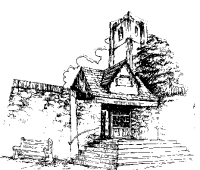
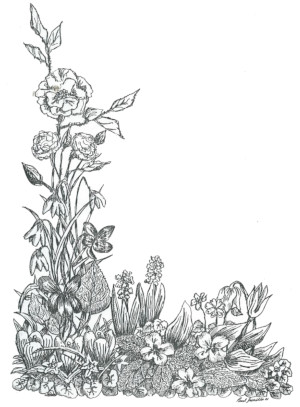
FROM REV. BILL
Easter
is a time to which most of us look forward.
Good things happen at Easter - better weather [sometimes], holidays,
Easter eggs, parties, family gatherings, etc.
Easter
is the Day in the Christian calendar when we celebrate the Resurrection of Christ
following his death on a cross. We are
reminded that God loves us and that we have certain hope for the future. In Jesus Christ, God came to us, died in our place so
that our sins can be forgiven and through faith in him can have eternal life
and begin a good and growing relationship with Him.
Easter
is about new life, new beginnings, new attitudes and new growth. For those in the church we can begin to
build on those decisions we made in Lent to change for the better, perhaps to
do something positive. Without Easter,
the Church [the people of God] wouldn't exist, but in this country fewer and
fewer people are coming to a growing and real faith in Jesus. Some are turning to other religions, many of
which offer rules that only subordinate.
Easter
brings forgiveness that through Jesus we can let go of all those things that
mar our relationship with God. It never
ceases to amaze me how some people, even Christians, live with so much bad
stuff [baggage] in their lives for so long.
Jesus calls us to 'let it go' [forgive] and start again. And following forgiveness comes joy: joy in knowing that Jesus has set us free:
free to live the kind of unselfish life our country is crying out for:
"All believers were together... praising God and having
favour with all the people. And the Lord added to their number day by day those
who were being saved." [Acts 2:44, 47]
HAPPY EASTER!
Bill
If you
are interested in knowing more about what it means to be a Christian, why not
come along to one of our home groups?
We have three groups meeting on different days and at different
times. Give me a ring on [01271] 523441 or
email: billcole124@btinternet.com.
Illustration by: Paul Swailes
30
MOVERS AND SHAKERS - NO. 80
SIR CHARLES HUBERT HASTINGS PARRY Bt.
[27th February 1848 - 7th October 1918]
Composer. Teacher and Music Historian
A regular contributor to our newsletter
suggested that Hubert Parry might be a suitable Mover and Shaker. Having looked into his life and career, even
though he wasn't a West Country man, he certainly moved and shook the musical
scene!
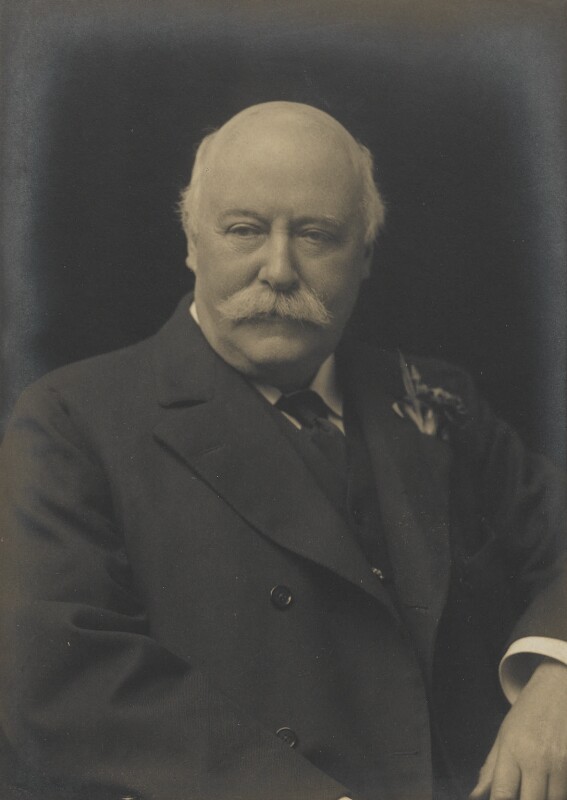
Sir (Charles) Hubert Hastings Parry, 1st Bt
by Walter Stoneman, for James Russell & Sons
bromide print, circa 1916
NPG Ax46144
© National Portrait Gallery, London
Licenced under CC BY-NC-ND 3.0
Hubert was born into a wealthy family. His parents were Thomas Gambier Parry and
his first wife, Isabella [nëe Fynes -Clinton]. Thomas, the youngest of six children, had
been orphaned at the age of five and was brought up by his maternal family
adopting their name, Gambier, as part of his surname. His grandfather had acquired enormous wealth
as director of the East India Company, much of which was passed on to Thomas,
who with his riches was able to buy a country seat, 17th century Highnam Court
near the River Severn, just two miles west of Gloucester.
Thomas was also a collector of fine
arts, and music too, having studied piano and French horn whilst at Eton. His wife, Isabella, died of consumption aged
just 32, only twelve days after giving birth to Hubert.
He,
and his second wife, Ethelinda, produced another six children, giving her
little time for the older ones.
Hubert's nearest sibling was Clinton, who
was at boarding school, and his sister Lucy was seven years his senior. His three other siblings had all died in
infancy. With his father away much of
the time, Hubert's main support was his governess.
Much of his education was at Eton. He received a setback at the age of 13 when
his sister Lucy died of consumption and in the same year, Clinton was sent down
from Oxford for womanising, drinking and taking opium, so homelife was not
good! His father was against Hubert
having a career in music and wanted him to have a conventional one in commerce. Thus, at Oxford, he read law and modern
history, his musical interests taking second place.
From 1870 to 1877, Hubert was an
underwriter at Lloyds of London. He found the work uncongenial but stuck to it
to please his father and in-laws. In
1872 he married Elizabeth Maude Herbert, daughter of the politician Sidney
Herbert and his wife Elizabeth, who all also felt that a career in music was
not suitable. Hubert and Elizabeth had two daughters,
Dorothea and Gwendolen [named after George Eliot characters]. During his time in insurance, he continued
with his musical studies at which he was far more successful so that by 1880
his first major work was premiered: a piano concerto. This was followed by the first of a series of
choral works: scenes from Shelley's Prometheus Unbound. In 1883 he was appointed Festival Conductor
of Oxford University and then Professor of Composition and Musical History at
the Royal School of Music under the then Head, George Grove who had used him as
a contributor to his own massive Dictionary of Music and Musicians.
Twelve years later, Hubert became the
Head himself when Grove retired, a position he held for the rest of his life. In 1900 he became Professor of Music at
Oxford. Just to add to his accomplishments,
he received a Knighthood in 1898 and a Baronetcy five years later. Because he had no sons, this baronetcy died
with him.
Many of his contemporaries rated his
talents as exceptional. However, Frederic
Delius did not. Neither did Bernard Shaw, at the time a music critic in London,
who mocked Hubert's lack of sympathy with his oratorios based on the Bible.
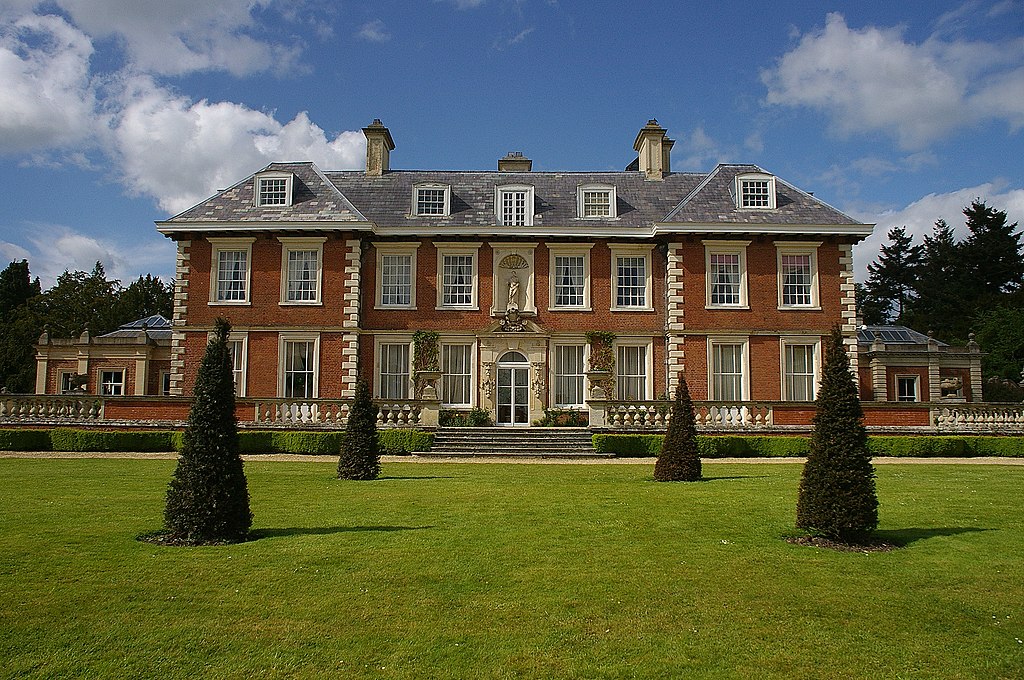
Highnam Court, home to Hubert Parry during his life time
©mattbuck (category), CC BY-SA 2.0, via Wikimedia Commons
Many of Hubert's pupils, including
Ralph Vaughan Williams, Gustav
Holst, Frank Bridge and John Ireland, all rated him highly, both as a composer
and teacher. Praise indeed! Edward Elgar was also greatly influenced by
him.
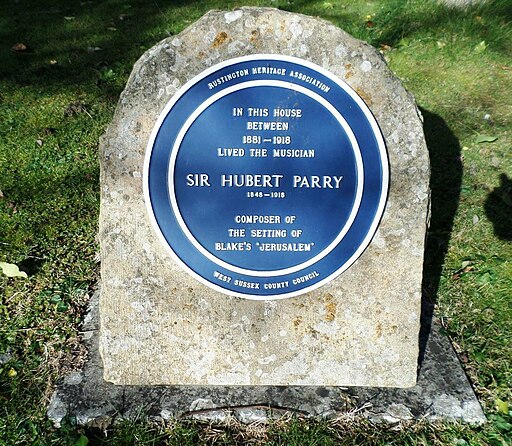
Sir Hurbert Parry, Rustington
©Sidpickle, CC BY-SA 4.0, via Wikimedia Commons
Although his academic work took up much
of his time, over the years he composed a wide variety of music, including 5
symphonies, organ recitals, music to accompany various plays and incidental
music for West End productions. His
works have had revivals in the late 20th and early 21st centuries and as
recently as May 2015, seventy unpublished works by him were found in a family
archive and recently auctioned.
But to most of us, what is probably his
most famous claim to fame is as the composer for setting the poem Jerusalem to
music. Written by William Blake and
printed in 1808, Blake called it 'And did those feet in ancient times', as a
preface to his epic 'Milton: A poem in Two Books'.
As all
Women's Institute members past and present will know, this became their anthem
in the mid 1920's.
It had earlier beginnings, though. Hubert Parry composed the music in 1916, to
'brace the spirit of the nation' during the dark days of the First World War. When
Millicent Fawcett [see the article about her in the June 2018 newsletter] asked
him if it could be used by the suffrage movement saying, "Your Jerusalem ought
to be made the women voters' hymn", he agreed, for both he and his wife were
keen supporters of women's rights.
Millicent
felt it was more in keeping for the suffragettes than the dreary 'Shoulder to
Shoulder', and infinitely less strident than Ethel Smythe's 'March of Women'. It was first sung by a mass of women at the
Royal Albert Hall at a suffrage rally to celebrate their right to vote in 1918.
One suffragist and also a founder and
Vice-chairman of the W.I was Grace Hadow. She organised a nationwide competition for a
W.I. anthem in the 1920's and was so depressed by the results that she had a
brainwave: why not transfer Jerusalem from the suffrage group to the W.I? After
all, both sides were concerned with giving more power to women; both sides were
bracing and inspirational.
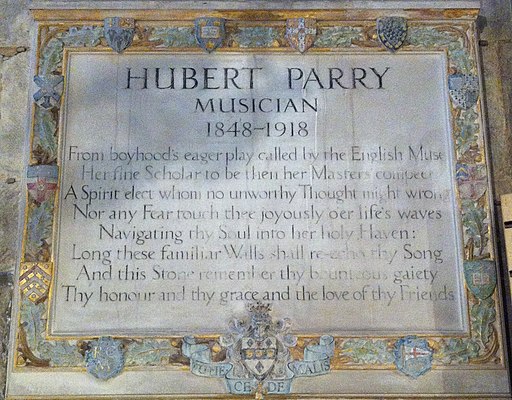
Parry's Memorial to Parry in Gloucester Cathedral
©Andrewrabbott, CC BY-SA 3.0, via Wikimedia Commons
From the 8th Annual General Meeting held
in the Queen's Hall, London on the 20th and 21st May 1924, and filled with delegates and visitors from all around the
country, Jerusalem was sung lustily, after the National Anthem.
It wasn't adopted then. It was
after Millicent Fawcett wrote to Hubert
Parry that it became their official anthem. All members pledged to learn the words and
tune by heart, and be 'ready to sing whether she thinks she can sing or whether
she thinks she can't'.
Not only the W.I. but famous singers
including Harry Secombe, Charlotte Church and Lesley Garrett have all featured
it. It appears at the Last Night of the
Proms and has even been hinted as a replacement of God Save the Queen - in
England at least!
Sir Hubert resigned his Oxford Professorship
in 1908 on medical advice and over his last ten years wrote some of his best-known
works, including of course Jerusalem.
In the autumn of 1918, he contracted
the worldwide pandemic of Spanish flu and died on October 7th. He is buried in the OBE Chapel in the crypt of
St Paul's Cathedral.
But what a legacy! Without him, his students might not have
developed so prolifically, the world would have been denied his great musical
works and the Women's Institute would not still be lustily singing Jerusalem at
their meetings, whether or not they think they can sing!
Thank you, Sir Hubert Parry.
PP of DC
P.S. An article in the Telegraph on 12th March
caught my eye, "Call us dinosaurs but film of fossil hero didn't need same-sex
affair". This was reporting the start of filming
Ammonite, the day before in Lyme Regis.
The comments from various relatives around the world were that there was
no evidence to prove that Mary Anning was a lesbian, and that she should be
remembered only for her lifetime success.
What did I say in my article in February?
One comment was, "Too few have even
heard of her name, let alone her remarkable achievements . . . At least this
way Mary Anning's name will get more recognition even it it's because of a daft
Hollywood blockbuster!"
That says it all!
31
Scrapbook Jokes!
Q. Why should travellers avoid the 12.40 train?
Q. Why should a sailor know whether there is a man in the moon?
Q. Why are cowardly soldiers like butter?
Q. What is worse than raining cats and dogs.
A. Because it's ten to one if they catch it.
A. Because he's been to sea!
A. Because when exposed to fire they run.
A. Hailing buses.
32
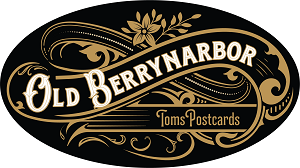
BERRYNARBOR VIEW NO. 178
Easter Wishes
For this issue I have chosen a selection of early Easter
cards which I hope you will enjoy. Easter Greetings shows two March Hares with their
Easter eggs. Published by Wildt &
Kray of London, in their series 1183, was sent on the 12th 1911.


A Bright
happy and Joyous Easter was published by E.A. Schwerdfeger & Co. of London
and printed in Germany. It shows
two chicks carrying a pink egg filled with flowers in the form of a sedan chair
with the message, "This car is a patent there is no doubt, You don't see many
like this about." Interestingly, the
reverse address side is printed the opposite way up.
Easter
Greetings, printed in Germany, shows a young lad carrying his sister. Her shoulder basket contains four chicks,
but one has popped out! A Happy
Easter, printed in Germany c1904 and numbered 298 depicts a hare with a sack of
Easter eggs, contained within an egg shape surrounded by pussy willow.


The
final card, May Your Easter Be Bright with the words 'May your Easter brighter
be Because I've not forgotten thee', has a 1918 postmark with a message 'Buy
National War Bonds Now'. The lady chick
wears a pretty blue bonnet, whilst he wears a bowler hat and is smoking a pipe!

Finally,
I should like to wish all readers A Very Happy Easter 2019 and thank Judie for
the very good quality Newsletter she produces these days.
Tom Bartlett
Tower Cottage, March 2019
e-mail:
tomandinge40@gmail.com
33
BEAFORD ARTS - JEREMIAH

Beaford
Arts will be presenting Jeremiah, performed by Jack Dean, on Saturday, 8th
June. From the critically acclaimed rap
storyteller comes a raucous and stirring new show about one of England's
greatest forgotten revolutionaries.
To be
held at the Stables Barn, Bodstone Barton, doors open at 7.30 p.m.
Tickets: Adults £7.50, Under 16 £5.00, Family [2
adults and 2 Under 16's] £22.50. For
tickets please call [01271] 267850. Age
suitability: 12 plus
There will be no bar, so bring your own
drinks, soft drinks will be available to purchase. Also available to purchase, burgers and hot
dogs, and bring a blanket if it's typical British summer weather!
34
CROSSWORD ANSWERS
ACROSS
1. Beagley, 5. David, 8. Other, 9. Hundred, 10. Tyneside, 11. Pure, 13. Rumourmongers, 16. Sand, 17. Anointed, 20. Through, 21. Elbow, 22. Nelly, 23. Nursery.DOWN
1. Booster, 2. Ashen, 3. Larkspur, 4. Yehudi Menuhin, 5. Dunk, 6. Verdure, 7. Dodge, 12. Engineer, 14. Mongrel, 15. Sideway, 16. Satan, 18. Table, 19. Buoy.35
